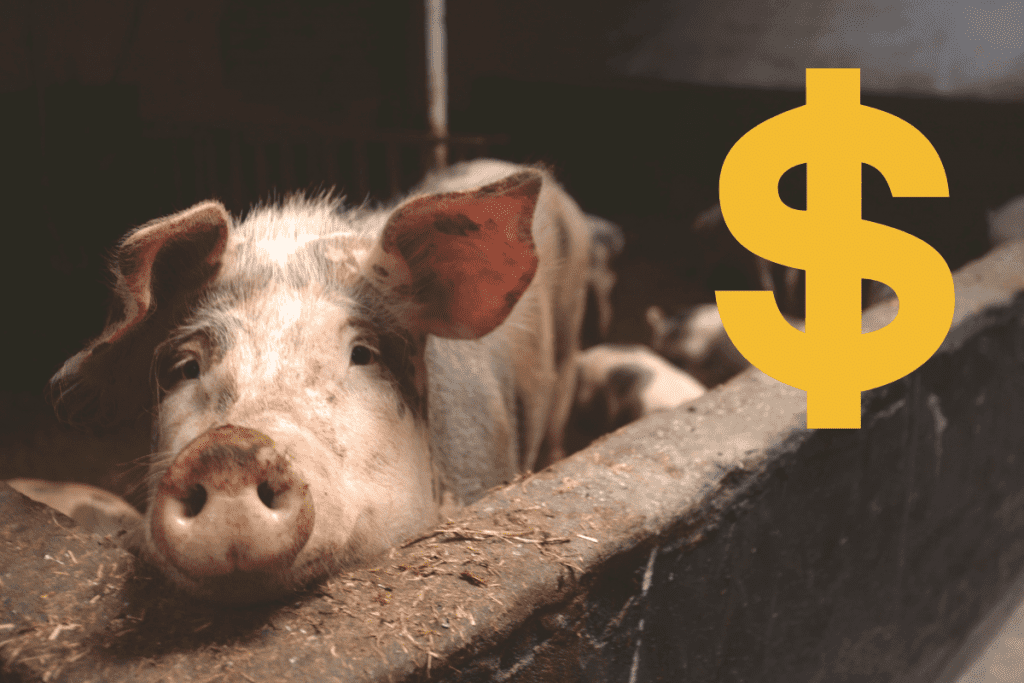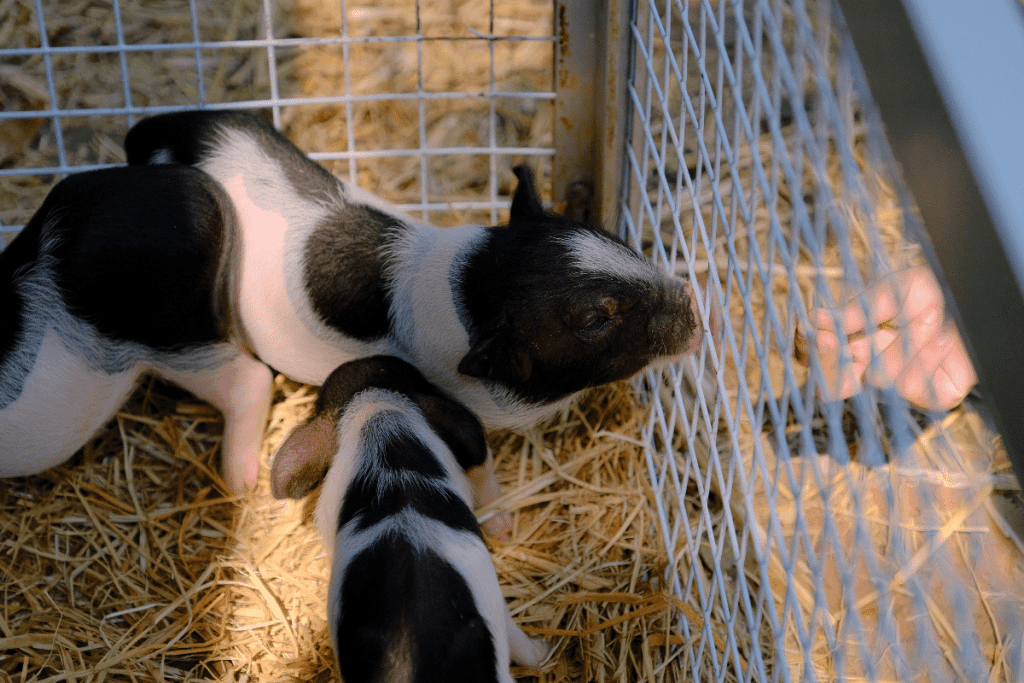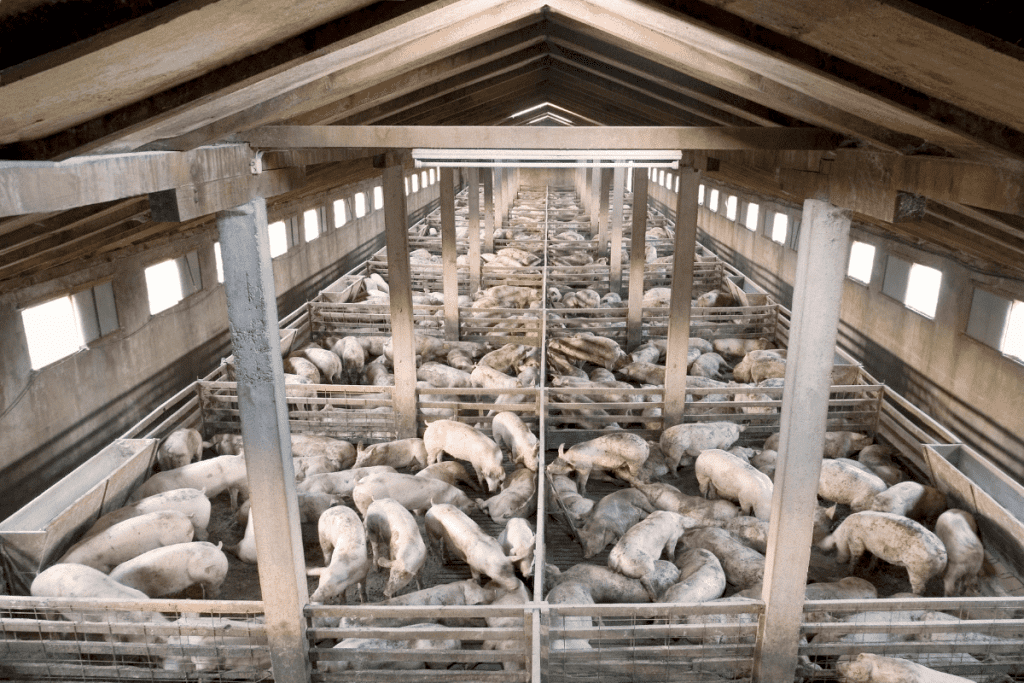There are many reasons to own a pig.
Some keep them as pets while others raise them for meat.
The actual cost of owning pigs is often much higher than those dreaming of farm-fresh bacon may realize.
There are quite a few factors impacting the overall cost, including climate, location, and age of the pigs.
The main costs include feed, shelter, veterinary bills, slaughter cost, and the initial cost of the pig itself.
The real cost of owning pigs ranges from $300-$800 a year, including feed, slaughter, and the initial cost of the pig. The price varies widely depending on the climate, age of the pig, and location. Warmer climates lower costs while colder climates increase. Older pigs tend to be more expensive as well.
There is quite a bit more than meets the eye when raising and owning pigs.
We’ll go over the cost breakdown of keeping and owning pigs.
Whether you plan to keep the pig as a pet or raise it for meat, we’ll let you know all the details and expenses associated with owning pigs.

Table of Contents
ToggleHow Much Does It Cost To Raise A Pig?
The cost of raising a pig depends on a few different variables.
The main expenses of raising a pig are feed, shelter, veterinary bills, and eventually slaughtering and butchering if you decide to sell the meat.
Most people who raise a pig for meat will buy a young pig, usually around 2 months old.
At this age, they are past nursing and ready to begin fattening up with commercial feed.
In areas with many pig farmers, these piglets will be very inexpensive.
In other areas where it is not as common, you’ll end up paying a lot more.
Depending on availability and demand, they generally range between $50-$200 or more.
Feed usually ranges around $100 per pig from weaning until butchering age.
This varies significantly depending on the availability of commercial feed and any methods taken to supplement feed.
Many farmers use garden scraps, table scraps, and foraging to supplement the hefty appetites of their pigs.
This is why it is significantly less expensive to raise your pigs in the summer months than in the winter.
Not only is there less foraging material and garden scraps, but your pigs will need to bulk up to keep their body temperature warm enough to deal with cold temperatures.
If you choose to slaughter and butcher your pigs at home, you will save quite a bit on this expense.
However, if you don’t quite have the skill or stomach to do it yourself, there are industry professionals who will do it for you.
Slaughtering averages about $60 per pig, and butchering averages about $100 per pig.
If you keep your pig as a pet, you don’t have to worry about this expense.
You will have to consider the rising cost of feed as your pig’s appetite grows along with its body mass.
The annual cost of keeping a pig as a pet ranges from about $500-$900 a year, depending on the size and age of your pet pig.
How Much Does A Pet Pig Cost?
A pet pig will cost significantly different than those raised for meat.
The expenses will differ as well.
Most pigs raised for slaughter are harvested around 5-6 months.
At this point, they are not eating nearly as much feed as a pig who reaches their full size at around 3 years of age.
A pet pig will also likely be of a specialty or heritage breed and cost more than feeder pigs.
Pet pigs will also hike up veterinary bills as they need more care as they age.
The average cost of a pet pig ranges from $250-$3000+ depending on the breed.
Adopting a pet pig tends to cost significantly less as well.
Many shady breeders are selling pot-bellied pigs as miniature and teacup pigs.
Unfortunately once the owner realizes how big their pet pig grew, they tend to get rid of them.
Luckily, many fantastic rescues work exclusively with surrendered pet pigs and rehome them.
There are quite a few expenses to consider when keeping a pet pig.
Here are the most common and recurring costs associated with keeping a pig as a pet:
| Type of Cost | Amount on Average | Frequency |
|---|---|---|
| Initial cost | $250-3,000+ | Once |
| Strong Fencing | $600-1000 | Once with fixes every year |
| Feed | $500-900 | Yearly |
| Spay/Neuter And Vaccine Vet Bills | $250-500 | Once |
| Vet Checkups For Routine Care | $150-300 | Yearly |
Pet pigs are not the least expensive animal to keep as companions, but they make wonderful companions.
Pigs are social animals.
They play very well with other pigs, dogs, cats, and children.
They make fantastic cuddle buddies and will turn some heads around the neighborhood.
Cost Of Owning A Teacup Pig

There is a rising interest in keeping them as pets with the rising number of adorable photographs of teacup pigs.
Unfortunately, many people don’t do the necessary research to understand what comes with purchasing a teacup pig.
Truthfully, there is no such thing as a teacup pig.
There are no pig breeds with pigs 25 lbs or less.
There are breeders falsely advertising for teacup pigs with guaranteed weights of no more than 25 lbs.
This is never the case.
Even the smallest miniature pig breeds reach 50 lbs, while most average between 100-150 lbs once they reach maturity.
Because miniature breeds tend to be smaller than feeder pigs, the cost of their annual feed will be significantly less.
Related: 10 Small Pig Breeds, Miniatures that Stay Small
Will I Make Money By Selling My Pig’s Meat?
Many backyard farmers and homesteaders consider raising feeder pigs to have a source of income.
While raising money by selling meat from your pigs is possible, the margin is often very thin.
This is especially the case if you live in an area where the overall cost is higher due to a lack of access to inexpensive feed.
There is also the factor of labor which is often quite intensive on pig farmers.
Hauling water and commercial feed to the pigs every day takes a toll.
Pigs are also capable of being significantly destructive.
You will likely have to be repairing fences, shelters, and anything else they find entertainment out of destroying.
The average cost of raising a feeder pig from weaning age to butcher is about $600.
The average feeder pig is slaughtered at 5-6 months at roughly 150 lbs.
At this rate, you’ll be able to sell the meat for a $4 price per pound to break even.
This does not include labor or unintended expenses associated with owning pigs.
Most farmer’s markets sell farm-fresh pork for about $4 price per pound as well.
This means you will just break even on your expenses while also putting a lot of work into getting your pig to slaughter.
We’ll go into more detail about how all those numbers add up and where the expenses are coming from.
Learn where to buy feeder pigs and how to save money.
Cost Of Feed
One of the highest costs of owning a pig is the cost of feed.
If you plan to keep feeder pigs for harvest, you won’t have to feed them for very long, but the cost is still an expense.
In most cases, the cost of feed from weaning age to slaughter age is around $100-$115.
There are ways to offset this cost by using other sources of food.
- Compost from the garden and leftover fruits, vegetables, and plants are a great way to supplement food for your pigs during the growing season.
- Table scraps from you and your family are another great way to offset the amount of commercial pig feed needed.
- Contact local bakeries and grocery stores to see if they are getting rid of any old bread. Many bakeries have to throw away things past their prime. Many pig farmers work to strike a deal with bakery owners to get lots of free or cheap baked goods for their feeder pigs.
- Finding a bulk distributor is another excellent way to cut down feed costs. Small feed and seeds or farm stores often have higher prices than those who sell food in bulk. You’ll save a lot of money by purchasing a lot of food at once rather than having to buy a new 50 lb bag every other week.
- Foraging and grazing is another easy way for your pigs to get more food. Pigs tend to quickly turn up every rock and find every plant scrap, grub, and insect.
(If you have a large property with plenty of acreages, you’ll probably be able to offset some costs with foraging and grazing around the property.)
Read more about how to care for pets pigs in our article at the link.
Initial Cost Of Piglet
The initial cost of the piglet will vary on a few factors.
Purchasing a heritage breed will undoubtedly hike the bill up for each piglet.
On average, most farmers keeping feeder pigs spend about $50-$250 per pig.
If you plan on spaying or neutering your pig or getting it all its shots, you’re looking at another $250-$500 within the first four months.
Some farmers will keep sows for breeding.
However, it is extremely expensive to keep a sow over the winter to breed her in the spring.
Cost Of Shelter
You will also need adequate shelter for your pigs.
This usually ranges between $350-$500 for a suitable shed shelter.
This will change based on heating or cooling needs depending on your climate.
Hay is cheap insulation but may not be enough for colder climates.
The cost of shelter will also vary significantly based on how many pigs you plan on keeping.
It’s important to provide a suitable outdoor environment for your pigs.
This will mean investing some money into the proper shelter as well as fencing for boundaries to keep your feeder pigs safe and healthy.
Cost Of Butchering And Slaughtering
The final cost in keeping feeder pigs is slaughtering and butchering.
Many pig farmers teach themselves how to properly do this to offset the cost of slaughter.
However, many first-time pig farmers do not have the skill or stomach to do the deed.
The average cost of slaughtering a pig is $60.
Sometimes it’s best to pay the slaughter fee to make sure it is done quickly, painlessly, and efficiently to cause as little distress to the animal as possible.
Once the pig is slaughtered, it will need to be butchered in cuts for eating.
Getting this professionally done usually costs about $100 per pig.
The butchering cost varies based on the slaughter weight of the pig.
This is a high cost but an important one nonetheless if you plan on selling the meat.
Having quality cuts will allow you to get a good price when selling the meat to a market and make it well worth the butchering cost if you are not confident in your skills.
Keeping A Pig Over Winter
Some people keep pigs, especially female pigs or sows, over the winter to breed them the following spring.
This tends to be significantly more expensive and costs more than raising pigs in the summer.
This is partially due to the lack of garden scraps and foraging in the winter.
It also increases because of the extra feed your sow eats during the winter to keep their body temperature and fat up for the cold weather.
Keeping a sow for breeding is one way to offset other costs involved in keeping feeder pigs.
If you impregnate your sow, litters usually range from 3 to 12 piglets.
Selling these piglets helps to cover costs for raising the other pigs.
Raising the piglets yourself until they reach slaughter age is another way to make your money back.
Many feeder piglets go for between $50-$250 per piglet after being weaned off their mother.
Pigs raised to slaughtering age will sell for quite a bit more.
Another important thing to consider in keeping a pig over the winter is the additional hard labor.
If you live in a climate with a lot of snow and freezing temperatures, you will be working against the elements.
You’ll need to haul fresh water daily through ice and snow to your pigpen.
You’ll also need to haul food and ensure your pigs are healthy and well-equipped against freezing temperatures, blizzards, and ice.
Ongoing Costs For Owning Pigs

The ongoing costs for a pig farmer or pet owner depend widely on whether you are keeping them for a pet or breeders.
Chances are, if you are breeding your pigs for meat, they will be slaughtered by 6 months of age.
Related: Best pig breeds for meat
Keeping a sow for breeding over the winter is incredibly expensive.
The sow will reach heavier weights and require more food to stay satisfied and healthy.
As the pig grows, it will require more and more food.
Mature pigs usually require around 5 lbs of feed per day.
Feed averages around $0.25 per pound.
On average, each pig will consume about $1.25 of food per day.
This will likely increase in the winter months.
Pigs need to consume more food to put on extra fat to keep them warm.
They also burn more calories in the wintertime, keeping warm.
If you keep your pig as a pet, you may keep them in the house with you.
If you do, you don’t need to worry about shelter or extra food in the wintertime to keep them warm.
You will still need to increase the daily feed needed until they reach their full weight and size at about three years of age.
However, most people who keep pigs as pets tend to spend more on veterinary visits, grooming, and toys for their porky little friend.
Veterinary Costs For Pigs
One expense for owning pigs with significant variation is veterinary costs for pigs.
You may never see an unexpected vet bill for the entirety of your pig’s life, or you may get handed a $4000 bill for a surgery or procedure.
It is hard to predict how much you will spend on veterinary bills for your pig, but some recurring costs are to account for.
The initial cost of veterinary visits involves spaying, neutering, and shots for your pig.
Some people opt against this for their feeder pigs, but those who keep them as pets will have to consider this.
The price of these initial vet bills ranges from $250-$500 and takes place during the first four months of the pig’s life.
If you adopt a pig, you likely won’t have to worry about these initial vet costs as the previous owner or rescue will likely have already taken care of these procedures.
On average, most people who either farm pigs or keep them as pets spend about $150-$300 annually from ages 1-11.
Once your pig becomes a senior, aged 12-20+ years of age, they will require a bit more routine procedures ranging from $300-$500 annually per pig.
These recurring costs include trimming tusks and hooves.
It also includes dental care, routine shots, and diagnostic testing.
How useful was this post?
Click on a star to rate it!
We are sorry that this post was not useful for you!
Let us improve this post!
Tell us how we can improve this post?
